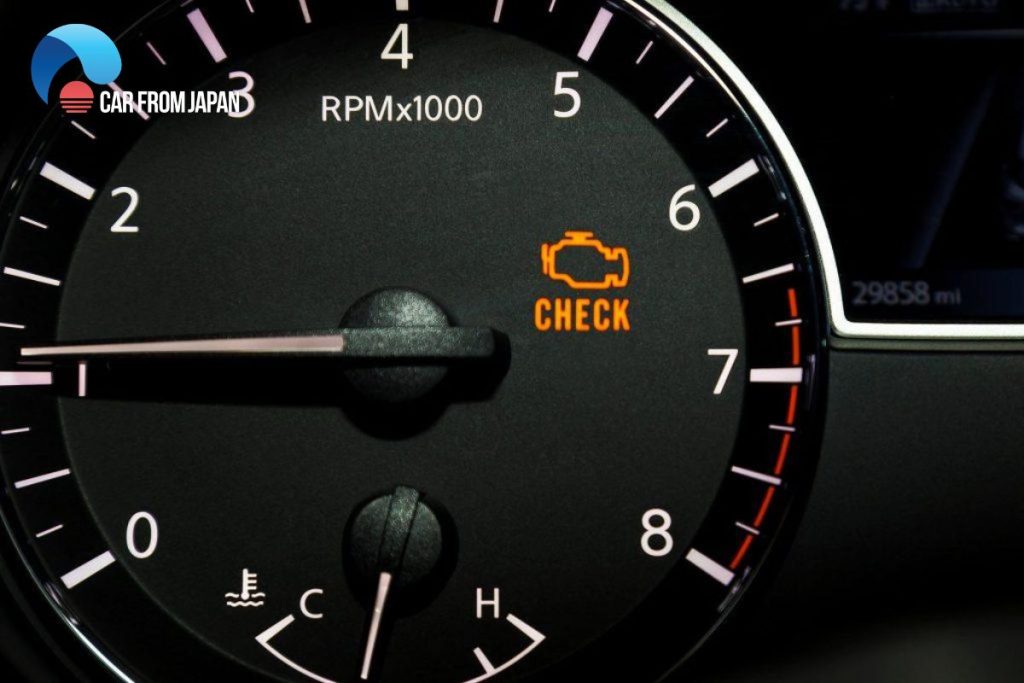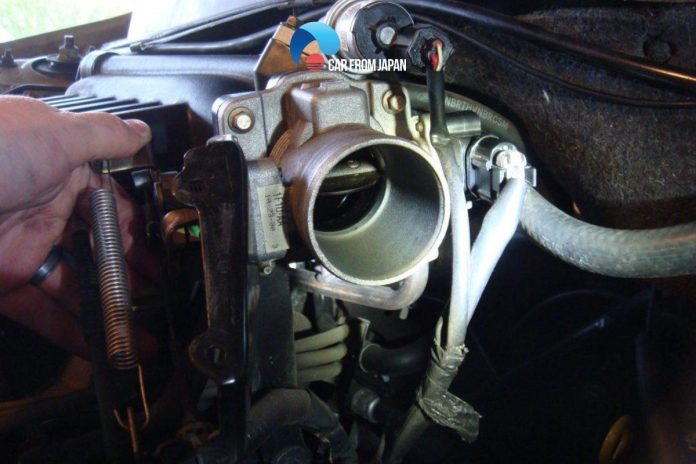The throttle position sensor is a critical component in your car’s fuel injection system. When it fails, it can cause a range of frustrating symptoms. What will happen if the throttle position sensor goes bad? This article will guide you through the common bad throttle position sensor symptoms, helping you identify the problem and get it fixed.
Contents
What Does A Throttle Position Sensor Do?
The throttle position sensor (“TPS”) is a component of your car’s throttle body system. It is located between the engine’s intake manifold and the air filter.
It is vital to ensure that a specific amount of fuel and air is delivered to your car’s engine as input for the engine’s combustion. Remember the Engine101 lesson: Your car’s engine requires a precise ratio of air and fuel mixture for optimal function.
Each time you press down on the gas pedal, the throttle butterfly valve rotates to let a precise amount of air enter through the engine’s intake manifold into the combustion chamber. As you press the pedal farther in, the valve opens more.
At the same time, the throttle position sensor sends out a signal to the Power Control Module to report the position of the throttle butterfly valve.
Simultaneously, a corresponding amount of fuel is instilled into the chamber, creating the ideal conditions for the combustion to take place.
To determine the exact amount of air needed for the engine at any specific time, the car’s computer, known as the Power Control Module, collects data continuously, as much as many times per second, including air mass flow, engine RPM, air temperature, the position of the throttle butterfly valve, and how fast the valve’s position sensor changes.
If the throttle position sensor and other sensors work well, your car will maintain optimal fuel economy and smooth handling. In other words, the engine will effectively receive the optimal fuel and air input to accelerate, coast, and cruise smoothly.
What Happens If Your Throttle Position Sensor Is Faulty?
The throttle position sensor can gradually fail or all at once. It can be faulty due to many causes.
In most situations, when there is an issue with the throttle position sensor, the Check Engine Light will turn on. Additionally, most carmakers supply a “limp home” mode of operation with decreased power if there is a failure in your engine. This is made to enable a driver to get off a crowded highway more safely.

When the throttle position sensor is faulty, your engine is not receiving the optimal amount of fuel, thus it is not working at optimal efficiency.
Remember that your engine is the utmost complex and delicate component, which requires every single part to work in perfect harmony and with precision. A tiny deviation in any element will reduce its efficiency, or even cause damage and shrink its lifespan.
Below optimal efficiency means poor fuel economy. This will be one of the most noticeable throttle position sensor symptoms you will encounter with a faulty sensor.
Bad Throttle Position Sensor Symptoms
Below are the most common symptoms of a bad throttle position sensor. Address throttle position sensor problems as soon as possible to avoid the risks of accidents and damaging your delicate engine.
1. Check engine warning light
One of the first bad throttle position sensor symptoms is the Check Engine Light will flash on your dashboard to warn you when any sensor goes bad. If the Check Engine Light is turned on, pay attention to any other strange signals and troubleshoot as soon as possible before the issue gets worse.
Read more: Check Engine Light Blinking And Car Shaking – The Reasons
2. Poor fuel economy
As mentioned above, due to the engine’s inefficiency, poor fuel economy will be one of the inevitable bad throttle position sensor symptoms. The throttle position sensor works alongside other sensors to ensure the engine gets everything it needs to run smoothly.
When these sensors start to go bad, your car’s computer receives incorrect data, leading to your engine getting incorrect inputs. Different parts try to overcompensate for these deviations.
For instance, if the engine is receiving more air than it needs, the computer will compensate by injecting extra fuel to rebalance the air-fuel mixture. Therefore, in most cases when your sensor goes bad, your car will be noticeably consuming more fuel than usual.

3. Engine rough idling or sudden stalling
Faulty throttle position sensors can cause rough idling due to fluctuating airflow. If you see your car misfiring, idling rough, or stalling out while you drive, you likely have a faulty throttle position sensor.
4. Startup and acceleration issues
Also due to fluctuating airflow, a bad throttle position sensor may cause all sorts of power issues. Your engine may start up but it will have little to no power, run briefly, but then die out.
Otherwise, it can also cause your car to have spontaneous surges during accelerations for no apparent reason, or cause weaker accelerations than usual.
5. Abrupt bucking or jerking
The throttle position sensor sometimes fails in a way that causes the signal sent to the engine’s computer to be sporadic. The effect will be similar to when you are quickly applying and releasing the gas pedal.
6. Difficulty in switching gears
If the throttle position sensor fails it can cause automatic transmission shifting problems. The throttle position sensor is important for proper automatic transmission control because it immediately establishes the driver’s intent, and transfers this information to the Transmission Control Module.
Without such correct and timely transfer of data, you will experience delay and/or difficulty in switching gears.
7. Your car goes into limp-home mode
In some models, a failing or faulty throttle position sensor can cause the engine to go into “limp-home mode”. In this situation, you will experience reduced engine power, and you may be stuck in a higher gear.
This is a safety feature designed to get you off the highway and allow you to drive a few extra miles to the nearest repair shop. Once this happens, do not drive any more than needed and get repairs immediately.
How to Repair A Throttle Position Sensor
Quick check
Once you’ve established the issue is with your sensor, check if the problems could be the result of faulty or loose wiring. Just like any other electrical wiring, your throttle position sensor is susceptible to corrosion and faulty connections.
Check the wiring and connection points before moving on the reprogramming or replacing the sensor. Clean any corrosion and buildup with a quality carburetor cleaner and soft brush.
First, locate the throttle position sensor. It should be mounted to your throttle body, which is on top of your engine.
The throttle position sensor is a small sensor that’s about the size of your key fob. It has an electrical connector attached to it that normally houses three wires. On most engines, two smaller screws secure it to the throttle body.
Once you’re aware of bad throttle position sensor symptoms and have performed the above quick check, you can choose to have a professional check it out and replace the faulty sensor.
While completely replacing your sensor may be the best way to avoid future issues, some issues can be easily fixed by reprogramming or repairing your sensor. This step can also be necessary when you install a new sensor. Learn this handy maintenance tip to save yourself time and trouble going to the mechanics.
Resetting the sensor
Resetting is sometimes all that is required to get rid of throttle position sensor symptoms and restore your sensor to proper function. The easiest way to reprogram or reset your throttle position sensor is to unhook the negative cable from your battery for up to five minutes or to remove the fuse for your Engine Control Module.
This is important, as it helps you avoid the risk of electrical shock or causing an error code on your Engine Control Module.
Don’t attempt this if you’re uncomfortable working with electricity, as removing the wrong fuse or cable from your battery could be dangerous. Sometimes, you’ll need professional software to reprogram your sensor. In this case, this task is best done by a professional mechanic.
Otherwise, sometimes your sensor is irreparably damaged. It needs to be replaced to restore your engine to its optimal efficiency.
Watch more:
How to Replace A Throttle Position Sensor
Remove the sensor
While removing the faulty sensor, take careful note of where each part and component is, so that you will be able to reassemble the new sensor easily later on.
First, disconnect your negative battery cable before removing the sensor. This helps you avoid the risk of electrical shock or causing an error code on your Engine Control Module. Your throttle position sensor should be attached using electrical connectors. These connectors are easy to remove using the tab on the side.
Once the electrical connectors are removed, look for the mounting screws on your sensor. Carefully unscrew and remove your throttle position sensor.
Install the new sensor
To make sure you buy the correct replacement sensor for your vehicle, consult your owner’s manual when shopping for a new one.
Install your new sensor by repeating the removal steps backward. Start by installing the sensor using the mounting screws. Then, connect your sensor to your vehicle’s electrical system using a convenient electrical connector. You should be able to easily push it together and hear a distinct click. Check to ensure a firm connection.
Connect your battery and now check if the replacement works. Start your car and test the idle and acceleration to see if the previous starting, idling and acceleration problems are resolved. Your car should idle smoothly and accelerate with adequate power.
Depending on your vehicle and the sensor you’ve installed, you may need to manually adjust the sensor. Other options allow automatic adjustments.
FAQs
Can you drive with a bad throttle position sensor?
Technically you can still drive with a bad throttle position sensor. However, do note that a bad throttle position sensor can cause an inability to shift up, rough or slow idle, and a lack of power when accelerating.
Driving with these symptoms will put you and other drivers around you in danger, so you should bring your car to a mechanic as soon as possible.
How long do TPS sensors last?
The batteries in the TPS sensors are made to last 5 years. They are built into the sensor so they can not be replaced like those of a flashlight.
Hence, it is recommended by car manufacturers to replace TPS sensors every 5 years to enjoy safe and hassle-free driving. Do not leave it until you’re encountering faulty throttle position sensor symptoms.
How much does it cost to replace the throttle position sensor?
The average price for replacing a throttle position sensor varies from $159 to $211. Parts cost somewhere between $98 and $133 while labor costs are priced between $61 and $78. The estimate does not include fees and taxes.
Do note that depending on what type of vehicle you have, labor costs could get more expensive. Sometimes, the throttle is not directly accessible and will require tons of disassembling like taking off the intake manifold and air filter box.
What happens if you disconnect throttle position sensor?
Disconnecting the throttle position sensor (TPS) will severely disrupt your car’s ability to run properly, and in most cases, it will prevent it from running at all.
Disconnecting the TPS is not a recommended diagnostic or repair procedure. It can cause damage to your engine and other components.




Thanks much for your in depth knowledge..I’m currently going through the above symptoms.my mechanic had tried working on it but I think the best thing is to replace!
hi good day! i have my car checked for high idling during start up and driving. the mechanic said that it has a problem with the throttle body. may i ask if it can be fixed or replaced. i prefer fixing first and i would like to ask your expertise on this problem.thank you. my car is toyota wigo 2014.im from philippines. thank you in advance for your help.
Dear Tsukasa Azuma.
I have 2000 Toyota Camry V6 XLE made in Japan.
There is some noise coming from Intake Manifold. It gets louder when you drive. It is made from metal. How to clean this one? I have checked all over internet to find the solution. Nobody seems to have similar problem. The car has around 200,000 miles on it. Other than that it runs well.
Regards.
Arvind Patel. Canada.
batteries on TPS? are you guys lost? TPS is a potentiometer or encoder, the second one having almost unlimited life, the first instead, has mechanical problems because of the internal friction of the wiper and tracks. please, review the article.